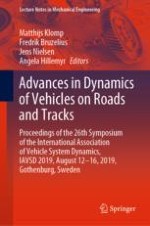2020 | Buch
Advances in Dynamics of Vehicles on Roads and Tracks
Proceedings of the 26th Symposium of the International Association of Vehicle System Dynamics, IAVSD 2019, August 12-16, 2019, Gothenburg, Sweden
herausgegeben von: Ph.D. Matthijs Klomp, Fredrik Bruzelius, Jens Nielsen, Angela Hillemyr
Verlag: Springer International Publishing
Buchreihe : Lecture Notes in Mechanical Engineering
